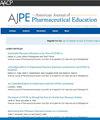Exploring Instructor-Led Team Formation and Task Assignment to Enhance Group Dynamics in Pharmacy Problem-Based Learning
IF 3.8
4区 教育学
Q1 EDUCATION, SCIENTIFIC DISCIPLINES
引用次数: 0
Abstract
Objective
This study investigates how different team grouping methods and task assignments affect group dynamics, specifically focusing on the presence of free riders and active learners (students who fully engage and contribute to the group).
Methods
This study was conducted in 2020 as part of a problem-based learning program in physical chemistry and pharmaceutics. A total of 255 second-year students were randomly assigned to 1 of 3 groups: (1) motivation-based, (2) grade-based, and (3) random. They were then divided into teams based on career prospects, academic performance, radom assignment. Data were collected using postprogram questionnaires which included demographic information, learning behaviors, and peer evaluations. Statistical analyses, including χ2 tests and analysis of variance, were used to compare group dynamics and learner characteristics. Qualitative comments on team performance were analyzed through coding and categorization.
Results
The grade-based group had the highest number of free riders, whereas the motivation-based group had the most active learners. Free riders demonstrated lower grades and self-evaluations, whereas active learners exhibited higher grades and leadership roles. Motivation-based grouping, which aligns team tasks with students' career prospects, was associated with higher engagement and fewer free riders. Grouping students based on career prospects promoted active learning, whereas grouping by academic performance increased free riding.
Conclusion
Grouping students from various academic performance levels may not yield positive outcomes, whereas grouping based on career prospects has the potential to enhance student motivation and engagement.
探索以讲师为主导的团队组建和任务分配,以增强基于问题的药学学习中的团队动力。
目的:本研究调查了不同的团队分组方法和任务分配如何影响团队动态,特别关注搭便车者和主动学习者(那些充分参与并为团队做出贡献的人)的存在。方法:本研究于2020年在一个以物理化学和药剂学为重点的基于问题的学习计划中进行。255名二年级学生根据其职业前景、成绩或随机分为三组:(1)动机组,(2)年级组,(3)随机组。数据是通过项目后问卷收集的,包括人口统计问题、学习行为和同伴评价。统计分析,包括卡方检验和方差分析,比较群体动态和学习者特征。通过编码和分类对团队绩效的定性评价进行分析。结果:Grade组的“搭便车者”人数最多,而Motivation组的“学习者”人数最多。主动学习者表现出较高的学习成绩和领导角色,而搭便车者表现出较低的学习成绩和自我评价。基于动机的分组,将团队任务与学生的职业前景结合起来,与更高的参与度和更少的搭便车者有关。根据职业前景对学生进行分组可以促进主动学习,而根据学习成绩分组可能会增加搭便车。结论:将不同年级的学生组合在一起的分组方法可能不会产生积极的效果,而基于职业前景的分组方法有可能增加学生的动机。
本文章由计算机程序翻译,如有差异,请以英文原文为准。
求助全文
约1分钟内获得全文
求助全文
来源期刊
CiteScore
4.30
自引率
15.20%
发文量
114
期刊介绍:
The Journal accepts unsolicited manuscripts that have not been published and are not under consideration for publication elsewhere. The Journal only considers material related to pharmaceutical education for publication. Authors must prepare manuscripts to conform to the Journal style (Author Instructions). All manuscripts are subject to peer review and approval by the editor prior to acceptance for publication. Reviewers are assigned by the editor with the advice of the editorial board as needed. Manuscripts are submitted and processed online (Submit a Manuscript) using Editorial Manager, an online manuscript tracking system that facilitates communication between the editorial office, editor, associate editors, reviewers, and authors.
After a manuscript is accepted, it is scheduled for publication in an upcoming issue of the Journal. All manuscripts are formatted and copyedited, and returned to the author for review and approval of the changes. Approximately 2 weeks prior to publication, the author receives an electronic proof of the article for final review and approval. Authors are not assessed page charges for publication.

 求助内容:
求助内容: 应助结果提醒方式:
应助结果提醒方式:


